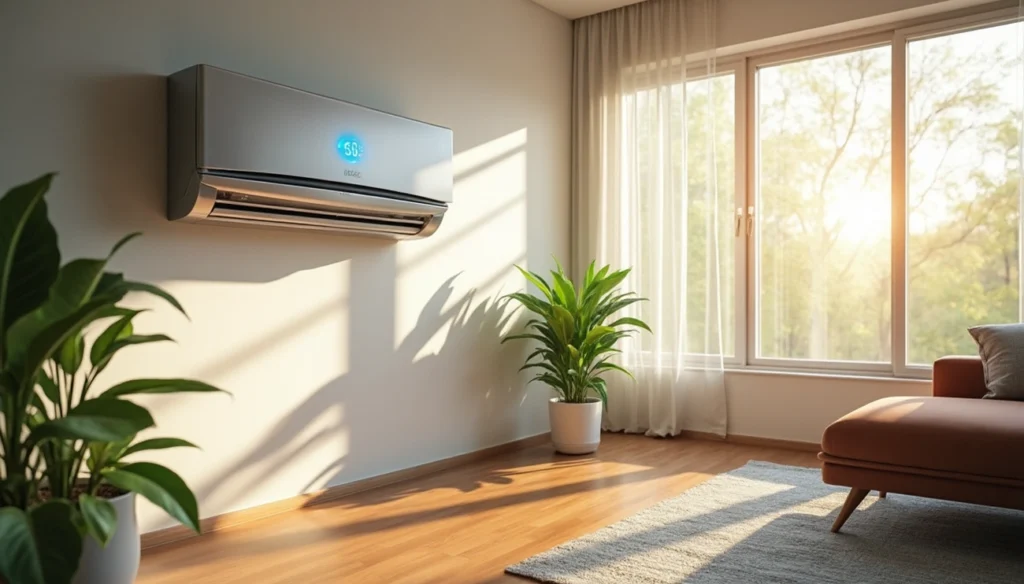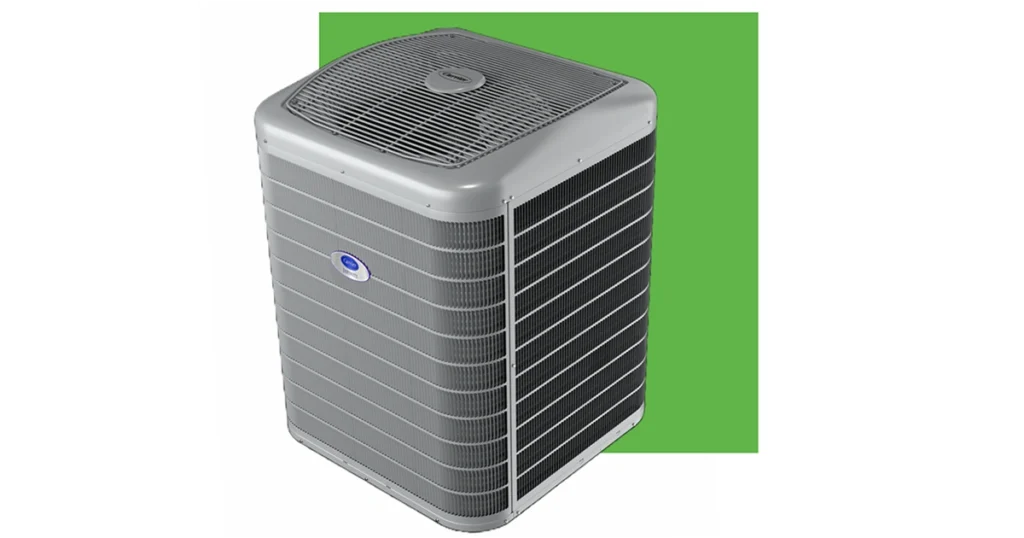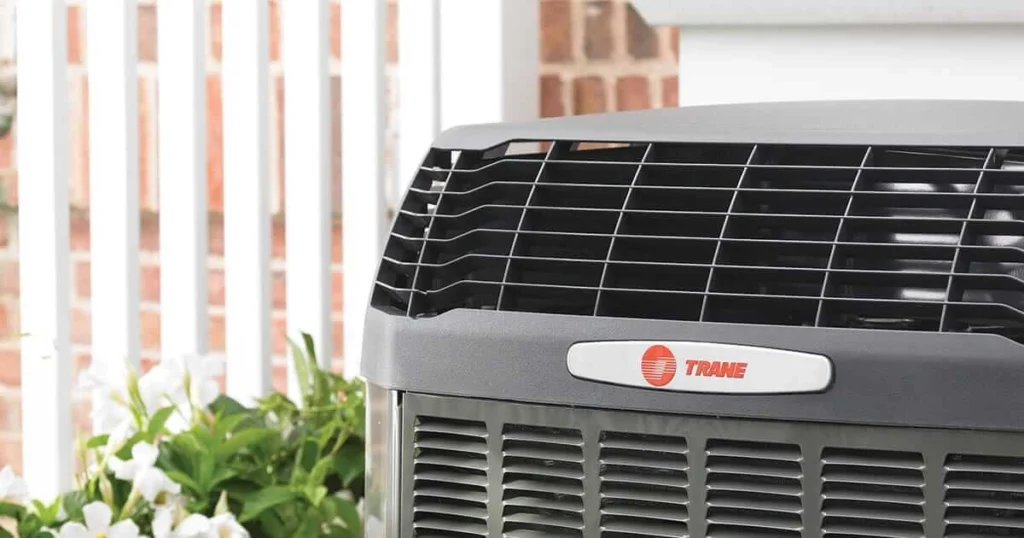
Finding the best home air conditioner feels overwhelming when you’re faced with countless brands and technical specifications that might as well be written in another language.
Summer heat doesn’t wait for you to become an HVAC expert, and making the wrong choice can lead to years of inefficiency, high energy bills, and inconsistent cooling. Furthermore, with most AC units representing a significant investment, the pressure to choose correctly is even higher.
That’s why we’ve done the hard work for you. We rigorously tested the top models from seven leading brands—Carrier, Trane, Lennox, Goodman, American Standard, Rheem, and Daikin—evaluating everything from cooling performance and energy efficiency to noise levels and long-term reliability.
Whether you’re replacing an aging system or installing central air for the first time, this guide breaks down exactly what you need to know before making your purchase. Let’s cut through the marketing hype and get to what actually matters when choosing the right cooling solution for your home.
1. Best Home Air Conditioners – Carrier

As the pioneer of modern air conditioning dating back to 1902, Carrier stands as an industry leader with a century-long reputation for quality and innovation. Their comprehensive range of residential AC systems balances cutting-edge technology with reliable performance.
Carrier key features
Carrier offers three distinct product lines to accommodate diverse homeowner needs:
- Infinity Series: Premium models featuring intelligent communicating technology, variable-speed compressors, and whisper-quiet operation (as low as 51 decibels) 1
- Performance Series: Mid-tier options balancing advanced features with affordability
- Comfort Series: Budget-friendly models with reliable cooling capability
Additionally, Carrier systems excel at humidity control through their variable-speed technology, which operates at lower speeds for longer periods to extract more moisture from indoor air 2. Their units also feature WeatherShield™ protection for coastal environments and space-saving designs for homes with limited installation areas 3.
Carrier energy efficiency
Carrier’s commitment to efficiency is evident across their product range. The Infinity Variable-Speed model with Greenspeed® Intelligence achieves an impressive SEER2 rating of up to 24 3, significantly reducing energy consumption. Even their mid-range Performance Series units reach SEER2 ratings up to 17 4, exceeding minimum efficiency standards.
All Carrier models now use Puron Advance (R-454B) refrigerant, which has a lower global warming potential than previous options 1. This environmentally conscious approach extends to their manufacturing processes and overall sustainability initiatives.
Carrier pricing
Carrier air conditioners generally fall into these price tiers (including installation):
| Series | Price Range | Features |
|---|---|---|
| Comfort | $3,000-$5,000 | Single-stage, standard efficiency |
| Performance | $5,000-$8,000 | Two-stage, better efficiency |
| Infinity | $8,000+ | Variable-speed, highest efficiency |
A standard 3-ton Carrier AC unit costs $5,000-$6,000 installed, while a larger 5-ton high-SEER model can reach $15,000 5. Factors affecting price include unit size, SEER2 rating, installation complexity, and additional features like smart thermostats.
Carrier best use case
The Infinity Series serves homeowners prioritizing maximum comfort, efficiency, and quiet operation, particularly in regions with extreme temperatures or humidity. Performance Series units offer an ideal middle ground for budget-conscious buyers still wanting enhanced features like two-stage cooling.
Comfort Series models suit homeowners seeking reliability without premium features, especially in moderate climates with less extreme cooling demands. Meanwhile, Carrier’s coastal models specifically target homes in salt-air environments where corrosion resistance is essential 3.
Consequently, Carrier provides extensive warranty protection, with most registered products receiving 10-year parts coverage 2, giving homeowners valuable peace of mind alongside their cooling investment.
2. Best Home Air Conditioners – Trane

Image Source: Trane
With over 120 years in the HVAC industry, Trane has earned its reputation as the “Cadillac of AC units” through rigorous testing and innovative cooling solutions 6. Every Trane air conditioner undergoes 16 weeks of extreme environmental testing to simulate five years of wear and tear, ensuring exceptional durability and performance 6.
Trane key features
Trane distinguishes itself through several standout technologies:
- TruComfort system provides precise temperature control through minute adjustments to cooling output, maintaining consistent indoor climate 7
- Climatuff compressor delivers reliable, quiet performance while enhancing efficiency 7
- Spine-fin coils resist corrosion and prevent refrigerant leakage 8
- CleanEffects filtration system removes pollen, dust, and other indoor pollutants 8
These features work together to create a comprehensive cooling experience, supported by Trane’s variable-speed technology which allows units to operate between 25% and 100% capacity depending on cooling needs 6.
Trane energy efficiency
Trane prioritizes sustainability with high SEER2 ratings across its product line. Their air conditioners range from 14.8 SEER2 in base models to an impressive 21.5 SEER2 in premium options 6. As of 2023, the Department of Energy updated minimum efficiency standards, requiring 14 SEER2 in northern states and 15 SEER2 in southern states 9.
Indeed, Trane is transitioning to the more environmentally friendly R-454B refrigerant, which has 78% less global warming potential than the previous R-410A 10.
Trane pricing
Trane systems represent a premium investment with corresponding quality:
| Model | SEER2 Rating | Installed Cost |
|---|---|---|
| XR14 | Up to 14.8 | $4,800-$6,800 9 |
| XR15 | Up to 15.6 | $6,000-$8,000 9 |
| XL17i | Up to 17.2 | $7,200-$10,000 9 |
| XV18 | Up to 18 | $6,300-$8,800 9 |
| XV20i | Up to 21.5 | $7,500-$10,000 9 |
Despite higher initial costs compared to some competitors, Trane’s efficiency ratings often translate to lower long-term energy costs 11.
Trane best use case
Trane’s variable-speed models excel in homes requiring precise humidity control and consistent temperatures. The XV20i, with its 21.5 SEER2 rating, is ideal for hot climates where cooling demands are high and energy costs significant 6.
Nevertheless, even base models like the XR14 offer above-minimum efficiency ratings, making them suitable for moderate climates. Trane’s comprehensive warranty (10-year parts, 12-year compressor, 20-year heat exchanger) provides valuable protection regardless of which model you choose 6.
For homeowners prioritizing long-term reliability over initial cost, Trane’s rigorous testing protocols and durable construction make their units a sound investment for the 15-20 year expected lifespan 12.
3. Best Home Air Conditioners – Lennox
Image Source: LennoxPros
Lennox stands out in the home air conditioner market as Forbes Home’s “Best Overall and Most Efficient Air Conditioner Brand of 2024” 13. Their product lineup delivers precise temperature control with some of the industry’s highest efficiency ratings, making them a top choice for homeowners seeking premium cooling solutions.
Lennox key features
Lennox organizes its products into three distinct lines:
- Dave Lennox Signature Series: Premium models with variable-capacity operation that adjusts cooling output like a dimmer switch 14
- Elite Series: Mid-range options balancing performance and price 15
- Merit Series: Budget-friendly models offering reliable cooling 15
These systems incorporate several innovative technologies:
- SilentComfort Technology: Enables whisper-quiet operation as low as 58 dB (comparable to a microwave) 16
- Precise Comfort Technology: Constantly adjusts in tiny increments to maintain exact temperature 16
- Quantum Coil Technology: Prevents corrosion for extended durability 16
Moreover, Lennox air conditioners feature proprietary cabinet designs with secure panels to reduce noise and provide easy access for technicians 14.
Lennox energy efficiency
Lennox leads the industry in efficiency ratings, with their flagship SL28XCV achieving an impressive 28 SEER/25.8 SEER2 rating 16. Even their mid-tier Elite Series units reach up to 22.50 SEER2 14, far exceeding the Department of Energy’s minimum requirements of 14 SEER2 in northern states and 15 SEER2 in southern states 17.
In fact, upgrading to a newer, high-efficiency Lennox unit can reduce cooling energy costs by 20% to 40% compared to a 10-year-old air conditioner 18. Lennox has subsequently transitioned to 2025 Compliant Refrigerant (R-454B), which has a lower global warming potential than previous options 14.
Lennox pricing
Lennox systems represent a premium investment:
| Series | Price Range (Installed) | Features |
|---|---|---|
| Signature | $7,000-$13,000 | Variable-capacity, highest efficiency |
| Elite | $5,000-$8,000 | Mid-range performance |
| Merit | $5,000-$9,000 | Budget-friendly |
Installation costs typically add 10-20% to the total, ranging from $1,300-$3,000 depending on the model 18. Although the upfront cost is substantial, the long-term energy savings often offset this initial investment 19.
Lennox best use case
The Signature Series serves homeowners prioritizing maximum efficiency and precise comfort control, primarily in regions with extreme temperatures or high energy costs. Elite Series units offer an excellent middle ground for those wanting advanced features without the premium price tag.
Merit Series models suit budget-conscious buyers seeking reliable cooling performance in moderate climates. Since larger homes require higher capacity units, Lennox offers systems up to 5 tons (60,000 BTUs) suitable for spaces up to 3,000 square feet 18.
Undoubtedly, Lennox systems excel in homes where energy efficiency, quiet operation, and smart home compatibility are essential priorities 15.
4. Best Home Air Conditioners – Goodman
Image Source: The Furnace Outlet
Known for delivering value without compromising quality, Goodman combines affordability with reliable performance. The brand stands out as a manufacturer that maintains its production facilities in the USA, having invested $400 million in a state-of-the-art Texas facility 20.
Goodman key features
Goodman’s manufacturing quality is validated through ISO 9001 and 14001 certifications 20. Key features across their product lines include:
- Two-stage technology that provides part-load efficiency 21
- Variable-speed compressors in premium models for enhanced comfort 21
- Corrosion-resistant cabinets designed to withstand harsh conditions 22
- Tubular aluminized steel heat exchangers with wrinkle bend technology 20
Uniquely, Goodman maintains a Better Business Bureau A rating based on 16 performance factors 20.
Goodman energy efficiency
Goodman offers a range of energy-efficient options with SEER2 ratings from 13.4 to 24.5 23. Their most efficient models include:
Furthermore, Goodman was the first company to utilize the more environmentally friendly R-32 refrigerant in some models 5.
Goodman pricing
Goodman positions itself as a budget-friendly option, with typical installed costs around $4,500 ($3,500-$6,000) 24. This pricing structure makes them approximately 20-40% less expensive than premium competitors 5.
| Category | Models | Price Range (Installed) |
|---|---|---|
| Premium | GVXC20, GSXV9 | $4,500-$6,000 24 |
| Mid-range | GSX16, GSXC16 | $3,500-$4,200 24 |
| Economy | GSXN3, GSX13 | $3,000-$4,000 24 |
Goodman best use case
Goodman units excel for budget-conscious homeowners seeking reliability without premium pricing. Their systems are particularly suitable for:
- Rental properties requiring dependable cooling 5
- Homes in moderate climates where maximum efficiency isn’t critical 1
- Homeowners prioritizing strong warranty coverage (10-year parts, 10-year unit replacement) 20
With proper maintenance, Goodman systems typically provide 10-15 years of trouble-free operation 23.
5. Best Home Air Conditioners – American Standard
Image Source: American Standard
Established nearly 150 years ago, American Standard combines engineering excellence with durability to create cooling systems that stand the test of time. Their comprehensive product lineup offers quality options across various price points and efficiency levels.
American Standard key features
American Standard organizes their product lineup into three distinct tiers:
- Platinum Series: Premium models featuring variable-speed compressors and AccuLink™ communicating technology for precise temperature control
- Gold Series: Mid-range options including two-stage cooling and multi-speed technology
- Silver Series: Budget-friendly models providing reliable single-stage cooling
The brand’s innovative Duration Scroll compressors improve durability, hence extending system lifespan 2. Even more impressive, their dual-diameter fan system reduces air resistance and turbulence, allowing units to cool faster yet operate quieter 2.
American Standard energy efficiency
American Standard offers impressive efficiency ratings across their lineup. Their central AC units range from 13.4 SEER2 in base models to 23.6 SEER2 in premium variable-speed units 25. As of 2023, the company has transitioned to R-454B refrigerant, which has lower global warming potential than previous options 26.
| Series | SEER2 Rating | Energy Savings |
|---|---|---|
| Silver 13 | Up to 13.4 | Up to 41% 27 |
| Gold 16 | Up to 17.1 | Up to 44% 27 |
| Platinum 20 | Up to 23.6 | Up to 55% 27 |
American Standard pricing
American Standard positions itself in the upper mid-range price territory:
American Standard best use case
The Platinum series excels in homes requiring precise temperature control and maximum efficiency, particularly in extreme climates. Conversely, Gold models offer an excellent balance between performance and affordability, featuring up to six operating speeds for enhanced comfort 29.
For homeowners seeking reliable cooling without premium features, the Silver series provides dependable performance in moderate climate conditions 30. Certainly, every American Standard unit includes robust warranty protection—typically 10 years on parts with registration 2.
6. Best Home Air Conditioners – Rheem
Image Source: Rheem
Established in 1925, Rheem has crafted a reputation as a budget-friendly yet reliable HVAC manufacturer. The company recently embraced the 2025 refrigerant change, selecting R-454B for most units 31, showcasing their forward-thinking approach to environmental regulations.
Rheem key features
Rheem structures its offerings into three primary tiers:
- Prestige Series: Variable-speed models with inverter technology, delivering whisper-quiet operation and consistent temperature control 4
- Classic Plus Series: Two-stage units balancing efficiency and affordability 4
- Classic Series: Single-stage options focusing on reliability and value 4
Most units feature scroll compressors that improve efficiency while reducing operational noise—some running as quietly as 54dB 3.
Rheem energy efficiency
Rheem’s efficiency spans from budget to premium options with SEER2 ratings of 13 to 20.5 32. Their Variable-Speed RA20 leads the lineup with 20.5 SEER2 performance 32, whereas economy models maintain respectable 15.2 SEER2 ratings 4.
Rheem pricing
Rheem positions itself as substantially more affordable than premium competitors:
| Series Type | Price Range (Installed) |
|---|---|
| Budget Models | $3,000-$4,000 |
| Mid-tier Units | $4,000-$4,800 |
| Premium Options | $5,000-$7,600 |
Remarkably, Rheem units cost up to 50% less than premium brands like Trane or Carrier 32.
Rheem best use case
Rheem excellently serves budget-conscious homeowners seeking reliable cooling without premium pricing. Their Prestige Series suits those wanting long-term energy savings, whereas Classic Series models work perfectly for moderate climates or rental properties where initial investment is the priority 33.
7. Best Home Air Conditioners – Daikin
Image Source: J&A Heating and Plumbing
As the world’s largest HVAC manufacturer with a 95-year legacy, Daikin has built its reputation on pioneering inverter technology that forms the heart of their cooling systems. This Japanese-originated brand focuses on designing units that operate flawlessly even in extreme weather conditions 10.
Daikin key features
Daikin distinguishes itself through innovative design elements and technologies:
- Advanced Inverter Technology: Functions like cruise control in a car, minimizing temperature fluctuations while providing continuous comfort 6
- Streamer Air Purification: Eliminates up to 99.9% of certain viruses and inhibits mold growth by up to 99.9% within 24 hours 34
- Smart Control: Mobile app compatibility allows remote operation with voice control support via Google Assistant and Alexa 34
Notably, Daikin units feature anti-corrosion treatment on outdoor components, extending system lifespan 35. Their indoor units operate at whisper-quiet levels, producing sounds as low as 31 dB(A) 35.
Daikin energy efficiency
Daikin leads in seasonal efficiency implementation, with ratings reaching up to 24.5 SEER in premium models 36. Their variable-speed DX20VC stands out with this impressive rating 37, yet even base models maintain respectable 14.3-15.5 SEER2 ratings 37.
First among manufacturers to adopt R-32 refrigerant 10, Daikin demonstrates commitment to environmental responsibility. This refrigerant has lower global warming potential than previous options 38.
Daikin pricing
Daikin positions itself in the mid-range market segment:
| Model Series | SEER2 Rating | Installed Cost |
|---|---|---|
| Premium (DX20VC) | 24.5 SEER | $3,600-$6,100 37 |
| Mid-tier (DX16SA) | 16 SEER | $3,500-$4,900 37 |
| Economy (DX13SN) | 14.5 SEER | $2,300-$3,800 37 |
Daikin best use case
Daikin systems excel in environments requiring precise temperature control alongside energy savings. Their high-efficiency models suit homes in hot climates with extended cooling seasons 36. Plus, the brand’s commitment to durability makes them appropriate for coastal locations through corrosion-resistant design 35.
Through 12-year parts and unit replacement warranties 6, homeowners gain valuable long-term protection for their investment.
Conclusion
Choosing the right air conditioner ultimately depends on your specific needs, climate, and budget constraints. Each brand reviewed offers distinct advantages for different situations. Carrier stands out for its century-long innovation and variable-speed technology, while Trane excels in durability through rigorous testing protocols. Lennox leads the pack in energy efficiency with impressive SEER2 ratings up to 28, though this comes with a premium price tag.
Budget-conscious homeowners should certainly consider Goodman, which delivers reliable performance at 20-40% lower costs than premium competitors. American Standard balances quality and affordability across their three-tier system, making them suitable for various home types. Rheem similarly provides cost-effective options without sacrificing essential features, particularly appealing for moderate climates or rental properties.
First-time buyers might appreciate Daikin’s innovative approach, especially their advanced inverter technology and industry-leading warranties. Additionally, their anti-corrosion treatments make their units excellent choices for coastal environments.
Remember to evaluate factors beyond initial purchase price. Energy efficiency ratings directly impact your monthly utility bills, while warranty coverage protects your investment over time. Climate considerations also play a crucial role—variable-speed models excel in extreme temperatures and high-humidity regions, whereas single-stage units might suffice in milder areas.
The best air conditioner isn’t necessarily the most expensive or feature-rich model, but rather the one that addresses your specific cooling needs, fits your budget, and delivers reliable performance throughout its lifespan. Armed with this comprehensive comparison, you can now make a confident, informed decision about the cooling system that will keep your home comfortable for years to come.
Written by Northeast Technical Institute.
References
[1] – https://www.goodmanmfg.com/resources/hvac-learning-center/before-you-buy/what-is-seer-and-why-does-it-matter
[2] – https://airconditionerlab.com/american-standard-air-conditioner-reviews/
[3] – https://indoortemp.com/resources/important-facts-about-rheem-products
[4] – https://www.hvac.com/expert-advice/rheem-ac-reviews/
[5] – https://www.nationalairwarehouse.com/blog/are-goodman-ac-units-good-2025-performance-reliability-and-value-guide/?srsltid=AfmBOor9AhqrYC4SNt-J9kZHA15lrQE8Q6xK7OHH2p9jYtAY2442EyD8
[6] – https://airconditionerlab.com/daikin-air-conditioner-reviews/
[7] – https://www.techstarmechanical.com/the-ultimate-guide-to-trane-air-conditioners/
[8] – https://johnsservice.net/4-benefits-of-buying-a-new-trane-air-conditioner-this-summer/
[9] – https://todayshomeowner.com/hvac/cost/trane-ac-unit-cost/
[10] – https://betterhomeapp.com/blogs/articles/daikin-air-conditioners-review-2025-the-ultimate-guide-to-cooling-efficiency-and-comfort?srsltid=AfmBOooefwUXW_-uwALYqNYkcIknl6sjyvWGaW78vDUzUOTMSYmGotgT
[11] – https://modernize.com/hvac/best-air-conditioner-brands/trane
[12] – https://homeguide.com/costs/trane-air-conditioner-prices
[13] – https://www.prnewswire.com/news-releases/lennox-named-best-overall-and-most-efficient-air-conditioner-brand-by-forbes-home-302173978.html
[14] – https://www.lennox.com/residential/products/heating-cooling/air-conditioners/el22kcv
[15] – https://modernize.com/hvac/best-air-conditioner-brands/lennox
[16] – https://investor.lennox.com/news-releases/news-release-details/lennox-introduces-most-efficient-air-conditioner-low-gwp
[17] – https://www.lennox.com/residential/buyers-guide/guide-to-hvac/glossary/seasonal-energy-efficiency-ratio-seer
[18] – https://todayshomeowner.com/hvac/cost/lennox-ac-unit-cost/
[19] – https://www.harpcanhelpyou.com/about-us/blog/lennox-hvac-reviews-are-lennox-hvac-systems-worth-it/
[20] – https://www.goodmanmfg.com/about/why-goodman
[21] – https://www.goodmanmfg.com/resources/hvac-learning-center/before-you-buy/which-ac-features-can-save-you-money
[22] – https://comfortconnections.com/2024/07/01/why-goodman-ac-best-choice/
[23] – https://airconditionerlab.com/goodman-air-conditioner-reviews/
[24] – https://todayshomeowner.com/hvac/cost/goodman-air-conditioner-cost/
[25] – https://www.americanstandardair.com/resources/blog/what-is-a-good-seer-rating/
[26] – https://www.americanstandardair.com/resources/blog/r454b-energy-efficient-hvac-systems/
[27] – https://spurkhvac.com/top-air-conditioning-units-of-2025/
[28] – https://todayshomeowner.com/hvac/cost/american-standard-air-conditioner-cost/
[29] – https://www.americanstandardair.com/resources/blog/best-air-conditioners/
[30] – https://www.americanstandardair.com/products/air-conditioners/
[31] – https://www.rheem.com/air-conditioning/articles/what-to-know-about-the-2025-hvac-refrigerant-change/
[32] – https://todayshomeowner.com/hvac/reviews/rheem-air-conditioner/
[33] – https://modernize.com/hvac/best-air-conditioner-brands/rheem
[34] – https://deepchill.com.au/daikin-air-conditioners-2025-whats-new/
[35] – https://www.acdirect.com/blog/why-daikin-2-zone-mini-split-ac-heat-pump-comfort-efficiency
[36] – https://daikincomfort.com/blog-detail/what-is-seer-and-what-seer-do-i-need
[37] – https://todayshomeowner.com/hvac/cost/daikin-air-conditioning-cost/
[38] – https://daikincomfort.com/






